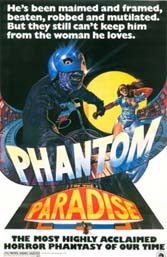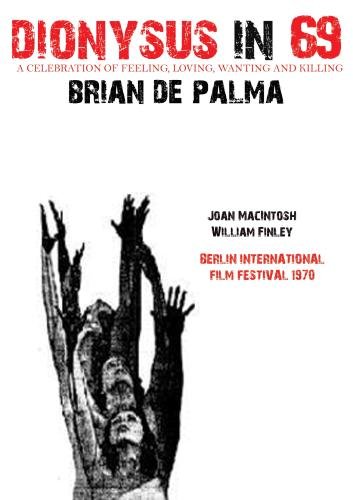ON DE PALMA'S 'FEMME FATALE' & 'PASSION'
"DOUBLE VISION" COLUMN NOTES HOW THE TWO FILMS "RHYME WITH EACH OTHER", DREAM IMAGERY & LOGIC, ETC. Dim The House Lights
Dim The House Lights began an “occasional column” this week called “Double Vision,” and the second installment finds
Ross Birks linking
Brian De Palma’s
Femme Fatale with his most recent feature,
Passion. “If you’re going to pair up two Brian De Palma erotic thrillers,” Birks writes, “nine times out of ten you’d go for
Dressed to Kill and
Body Double. Upon recently revisiting De Palma’s canon for the umpteenth time, however, I found a better pairing:
Femme Fatale and
Passion. Made ten years apart these two films showcase a late-career De Palma returning to the genre he helped define with a newfound enthusiasm and experimentation."
In between writing about the two films, Birks notes how
Raising Cain, made ten years prior to
Femme Fatale, "foreshadows what De Palma would explore" in these two later works. "In that film," Birks writes, "
John Lithgow plays Cain, a psychologist suffering from multiple personality disorder and De Palma constantly shows us the world from Cain’s POV in each of his different guises making reality increasingly difficult to pin down. The same can be said for the final act of
Passion. After being accused of murder, Isabelle (Rapace) appears to regress into her own consciousness. De Palma teases the audience with multiple fake outs and double fake outs, sometimes never clarifying what is real and what isn’t."
While Birks does not leave out mention of the use of dreams in De Palma's previous films, his focus on these three actually makes for an intriguing trilogy, each conveniently ten years apart (it is an odd recent phenomenon that a movie's film festival screening year has become its official year of release: Passion, which played several fests in 2012 but was not officially released in any country until 2013, is referred to in most cases, even the IMDB, as a 2012 film). Each of the three feature long, extended dream sequences in the middle of the film. The dream at the center of Femme Fatale is clearly delineated, yet the whole film comes to seem marked by a transcendent sort of dream logic that feels sprung from multiple dreamers. As such, it does make for a graceful centerpiece in a trilogy that would keep any audience on its toes, as the nightmares from Raising Cain and Passion keep the viewer guessing what is dream, what is real, and by the way, whose dream are we in now?
Birks continues, "Passion‘s centerpiece, at least from a De Palma obsessive’s point of view, is an extended split screen sequence that intercuts a ballet performance with a stealthy murder in the giallo tradition and culminates with Isabelle jolting awake in her bed just as Christine (McAdams) has her throat slashed open. For a time, it isn’t clear if the previous scene really occurred or was just a variation of what actually transpired. From then on the film becomes hyper-real, bathed in expressionistic shadows and Dutch camera angles that are at odds stylistically with the film’s rather composed first hour. Even the story becomes excessively nonsensical with twist piling on after twist to the point of absurdity. The 'it was all a dream' trope has become one of the most groan-worthy in cinema so De Palma’s commitment to it in both Passion and Femme Fatale is all the more daring and admirable. It’s as if he saw utilizing that twist as a challenge in itself and wanted to explore the possibilities. Perhaps if he was subtler about it audiences would have been more receptive (see Mulholland Dr.) but De Palma has never been about subtlety, which is actually one of things I respond to most in his work."







 The pilot episode of HBO's Vinyl is directed by Martin Scorsese, who created the series along with Mick Jagger. The pilot, essentially a new two-hour Scorsese picture, begins with its main character, Richie Finestra (Bobby Cannavale) scoring some drugs on a New York street before being shaken by rowdy partiers into abandoning his car to follow them via some sort of Dionysian impulse into a building where the New York Dolls are performing to a crowd of rabid fans. Finestra observes motionless, but drugged-out impressed as the band has the crowd eating out of its hands. A little later in the movie (actually, after the story has flashed back a handful of days prior to its opening), Finestra is riding in a car and spies the marquee of a movie theater showing a double feature: Deep Throat and The Devil In Miss Jones.
The pilot episode of HBO's Vinyl is directed by Martin Scorsese, who created the series along with Mick Jagger. The pilot, essentially a new two-hour Scorsese picture, begins with its main character, Richie Finestra (Bobby Cannavale) scoring some drugs on a New York street before being shaken by rowdy partiers into abandoning his car to follow them via some sort of Dionysian impulse into a building where the New York Dolls are performing to a crowd of rabid fans. Finestra observes motionless, but drugged-out impressed as the band has the crowd eating out of its hands. A little later in the movie (actually, after the story has flashed back a handful of days prior to its opening), Finestra is riding in a car and spies the marquee of a movie theater showing a double feature: Deep Throat and The Devil In Miss Jones.






 Today at
Today at  Brian De Palma's The Fury is now available to watch on Netflix Streaming, as well as on Amazon, iTunes, Vudu, Google Play, and YouTube.
Brian De Palma's The Fury is now available to watch on Netflix Streaming, as well as on Amazon, iTunes, Vudu, Google Play, and YouTube.